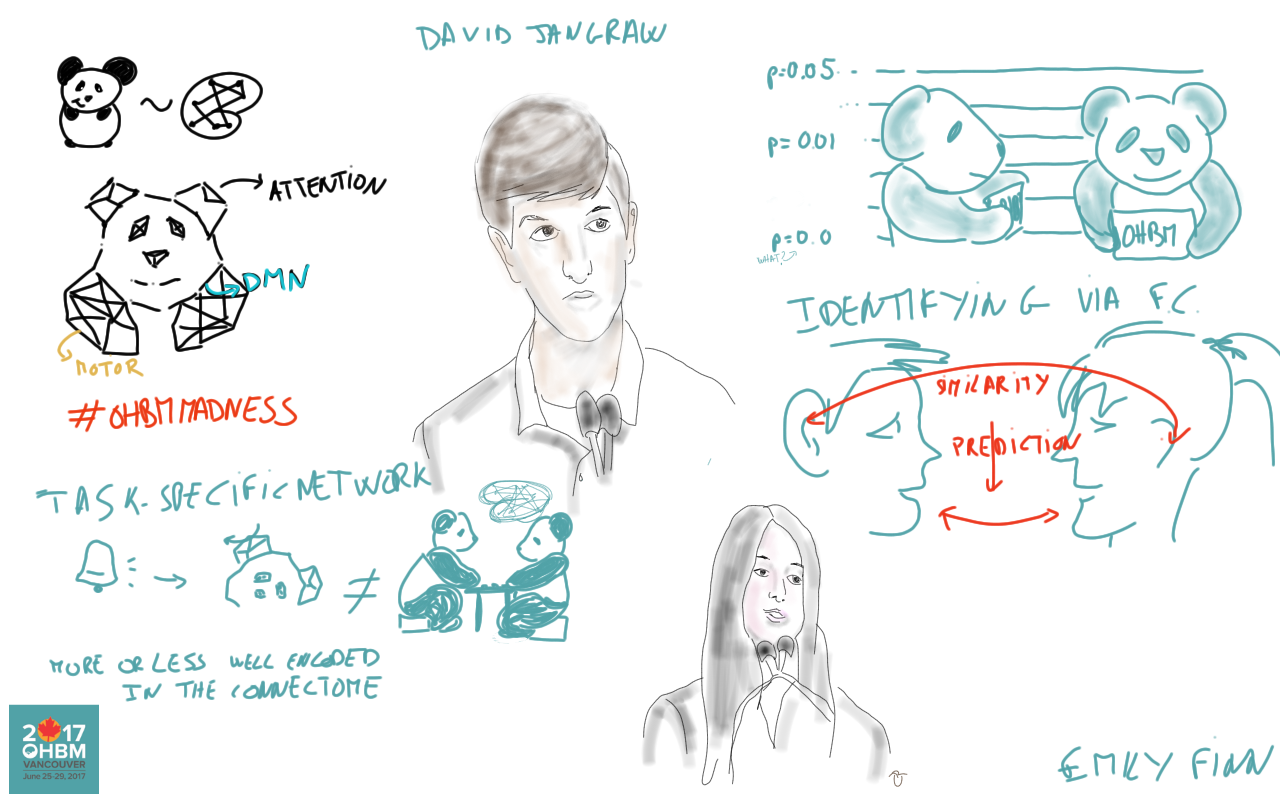This post is also available in Dutch.
Ever wonder what neuroscientists do at a conference? I attended one this past June, and was able to live-sketch it. So let me show you with tweets and drawings what it’s like to attend…
In June 2017, I attended the Organisation for Human Brain Mapping Conference (#OHBM2017) in Vancouver, Canada. At this conference, scientists from all over the world came together to find out about the year’s research highlights and results in the field. This was done through talks, often in the form of symposia, where a group of scientists give short presentations on their latest results around a shared topic, or in the form of a keynote speech where a recognised and leading figure presents their results in a longer talk.
A unique way to remember new knowledge:
As a scientist-artist, I was trying to turn some of these talks into drawings, sketching some main ideas and the speaker. Once the talk ended, the live-sketch was shared on twitter. So it was a battle against time! Of course, with multiple talks occurring in parallel sessions, I wasn’t able to draw all of the talks that took place, but here are the results:
Turning scientific presentations into drawings was actually a new idea. Conference attendees told me they would use the drawings as a summary and reminder of the content of the talk. For me, sketching also helped me stay focused throughout the dense program of the day.
Is science in crisis? Sharing new tools:
You may have recently heard that results aren’t often replicated. Well I am not going to begin with the why’s and why not’s, but let me tell you just say that this is not a recent concern for scientists. Scientists have been working on improving the process of doing science for a while. How? By sharing detailed information about how they conducted their study, so others can replicate their results more easily. But you need a variety of tools to enable this sharing and replication process.
I went into one room, and it was a full program filled with demos being given on new tools that the scientific community was creating, and making available in a free and open way. This allows for more robust, open and collaborative science.
Quick advice on how to preach about open science by @RCCraddock #ohbm2017 pic.twitter.com/jZZefTNlIc
— Chris Gorgolewski (@ChrisFiloG) June 24, 2017
Meet, discuss, make science:
Twitter is an important part of any conference nowadays. Let’s use it to see what people were able to do:
- Find new collaborations like data exchanges
I'm looking for someone who would be willing to publicly share a simultaneous EEG fMRI dataset. Please RT. #OHBM2017
— Chris Gorgolewski (@ChrisFiloG) July 1, 2017
- Find advice and jobs with mentoring events
Incredible panel & such useful information. I wish the career SIG had happened when I was in the job market. @OHBM_Trainees @OHBM #OHBM2017 pic.twitter.com/8rflHSsctg
— Javeria Ali Hashmi (@netphys1) June 28, 2017
Several positions available in my lab at NIH, focusing on affective neuroscience and pain. Get in touch if you'd like to meet at #OHBM2017! pic.twitter.com/6Kt7qRWq7z
— Lauren Atlas (@laurenatlas) June 27, 2017
- Find reconciliation: Interestingly, twitter triggered a vivid discussion between some scientists that was settled ‘in real life’ in one of the rooms of the conference centre: People left the discussion with a better understanding of one another, as opposed to all the resentment and anger that’s never resolved between international teams. #HappyEnding #WeWantMoreOfThat
Our twitter-inspired meeting made the #OHBM2017 meeting highlights! pic.twitter.com/BOIBQwWHIX
— Russ Poldrack (@russpoldrack) June 29, 2017
- Find an artistic escape with a great art exhibit
Impressive embroidered brain art #OHBM2017 pic.twitter.com/PrXkbGUtwz
— michelev (@micheleveldsman) June 27, 2017
- Make memories and friendships: because scientists are also just humans, they make jokes (putting pandas for no reason in their presentation) and party together (ok inside a science museum, which might be a bit nerdy, but we’re okay with that!)
#ohbm2017 El Día Final – twitter convo day 4. I do see party in there….just saying….
See you in Seoul! #OHBM2018 pic.twitter.com/YkQiR0KE7x
— OHBM (@OHBM) June 30, 2017
Now that you know what neuroscientists do at a conference, would you be interested in knowing more about the scientific contents? Let me know in the comments your ideas on how the organizers could reach out more to the general public. Would using live-sketching be one?
